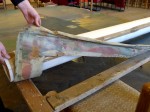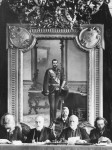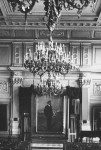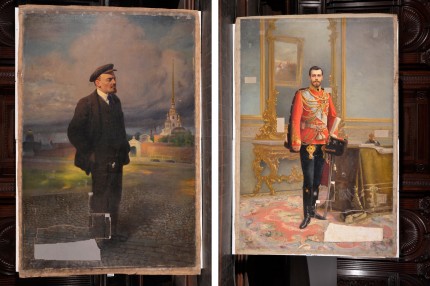 In the summer of 2013, the administration of St. Petersburg’s Primary School No. 206 called in the experts at the Stieglitz Art and Industry Academy to restore a portrait of Lenin that had a substantial damage to the canvas. In the larger than life-sized portrait (nine by six feet), Lenin looks pensively off to the side. Behind him is the Peter and Paul Fortress, the citadel and prison built by Peter the Great which became a symbol of Tsarist oppression akin to the Bastille, and the domes and golden spire of the Peter and Paul Cathedral, the church where all the Russian Tsars from Peter the Great on were buried.
In the summer of 2013, the administration of St. Petersburg’s Primary School No. 206 called in the experts at the Stieglitz Art and Industry Academy to restore a portrait of Lenin that had a substantial damage to the canvas. In the larger than life-sized portrait (nine by six feet), Lenin looks pensively off to the side. Behind him is the Peter and Paul Fortress, the citadel and prison built by Peter the Great which became a symbol of Tsarist oppression akin to the Bastille, and the domes and golden spire of the Peter and Paul Cathedral, the church where all the Russian Tsars from Peter the Great on were buried.
 There were multiple holes in the bottom left of the portrait. Restorers noticed a piece of boot on the other side of the canvas showing through the tears. When they removed the frame to examine the back, they found a painted over portrait of Tsar Nicholas II by Ilya Galkin Savich, a painter who was a favorite at the Imperial court. He painted Nicholas the year before he ascended the throne, at least twice immediately after he became Tsar Nicholas II, plus his wife the Empress Alexandra Feodorovna and his mother the Dowager Empress Maria Feodorovna. The newly rediscovered portrait was commissioned the year of Nicholas’ coronation to hang in the assembly hall of the Merchant Society’s Petrovsky Trade and Commercial School. Portraits of Peter the Great and Tsar Paul I, later destroyed by the Soviets, also hung in the assembly hall.
There were multiple holes in the bottom left of the portrait. Restorers noticed a piece of boot on the other side of the canvas showing through the tears. When they removed the frame to examine the back, they found a painted over portrait of Tsar Nicholas II by Ilya Galkin Savich, a painter who was a favorite at the Imperial court. He painted Nicholas the year before he ascended the throne, at least twice immediately after he became Tsar Nicholas II, plus his wife the Empress Alexandra Feodorovna and his mother the Dowager Empress Maria Feodorovna. The newly rediscovered portrait was commissioned the year of Nicholas’ coronation to hang in the assembly hall of the Merchant Society’s Petrovsky Trade and Commercial School. Portraits of Peter the Great and Tsar Paul I, later destroyed by the Soviets, also hung in the assembly hall.
 After the 1917 Revolution, the Trade School was turned into an elementary school. In 1924, artist Vladislav Izmailovich was commissioned to paint over the portrait of the last Tsar with a new portrait of Lenin. Izmailovich was a classically trained artist who studied at fine arts in St. Petersburg, Rome, Paris and Berlin. He lived in St. Petersburg at the turn of the century where he painted landscapes, genre scenes and was in demand as a portraitist. Izmailovich also painted decorative interiors at private homes of the wealthy and was hired to restore paintings at St. Michael’s Castle, a former royal palace converted into the army’s engineering school, and at the sumptuous Catherine Palace in Tsarskoye Selo.
After the 1917 Revolution, the Trade School was turned into an elementary school. In 1924, artist Vladislav Izmailovich was commissioned to paint over the portrait of the last Tsar with a new portrait of Lenin. Izmailovich was a classically trained artist who studied at fine arts in St. Petersburg, Rome, Paris and Berlin. He lived in St. Petersburg at the turn of the century where he painted landscapes, genre scenes and was in demand as a portraitist. Izmailovich also painted decorative interiors at private homes of the wealthy and was hired to restore paintings at St. Michael’s Castle, a former royal palace converted into the army’s engineering school, and at the sumptuous Catherine Palace in Tsarskoye Selo.
 His work for the moneyed elites, up to and including the royal family, did not harm his artistic career after the October Revolution. Prominent Marxist figures became subjects of his portraits. He made one of the first portraits of Lenin, a pastel in 1918. Other portrait subjects were founder of the German Communist Party Karl Liebknecht in 1918, a year before he became a socialist martyr in the failed Spartacist uprising, Anatoly Lunacharsky, the first Soviet People’s Commissar of Education, in 1920, and national heroes like chemist Dmitri Mendeleev and Leonid Govorov, defender of Leningrad during World War II. Izmailovich also painted historic scenes and landscapes, managing to survive many a purge and vanishing commissar to work until just before his death in 1959 a few months shy of his 87th birthday.
His work for the moneyed elites, up to and including the royal family, did not harm his artistic career after the October Revolution. Prominent Marxist figures became subjects of his portraits. He made one of the first portraits of Lenin, a pastel in 1918. Other portrait subjects were founder of the German Communist Party Karl Liebknecht in 1918, a year before he became a socialist martyr in the failed Spartacist uprising, Anatoly Lunacharsky, the first Soviet People’s Commissar of Education, in 1920, and national heroes like chemist Dmitri Mendeleev and Leonid Govorov, defender of Leningrad during World War II. Izmailovich also painted historic scenes and landscapes, managing to survive many a purge and vanishing commissar to work until just before his death in 1959 a few months shy of his 87th birthday.
 It’s fascinating to think that this survivor secretly saved a portrait of the Tsar, disguising it instead of destroying it. He painted the portrait of Lenin on the reverse side, painted over the Tsar until the portrait of Nicholas was thoroughly hidden. Izmailovich used layers of greyish-white water-soluble paint that not only allowed future restorers to remove it without damaging the original painting, but actually preserved the original work.
It’s fascinating to think that this survivor secretly saved a portrait of the Tsar, disguising it instead of destroying it. He painted the portrait of Lenin on the reverse side, painted over the Tsar until the portrait of Nicholas was thoroughly hidden. Izmailovich used layers of greyish-white water-soluble paint that not only allowed future restorers to remove it without damaging the original painting, but actually preserved the original work.
The decision to go through with the restoration process was kicked off by an initial X-ray result, in which “we were shocked, almost to the point of humor, to discover Czar Nicholas II’s head nearly exactly the same size and placement as Lenin’s,” confirming their suspicions that there was a completed full-size portrait beneath the water-soluble paint. The restoration experts used baby soap and water to wash the paint off and reveal a “remarkably intact and preserved” portrait of Czar Nicholas II, signed by the Russian artist Ilya Galkin Savich.
Ms. Pozeluyeva and other experts at Stieglitz believe that in 1924, Izmailovich painted over the Czar Nicholas II work — still in its frame — as an urgent act of “protection” and “sympathy for the Imperial era.”
Izmailovich’s secret tsarist leanings created a unique art work: a massive double-sided formal portrait of two leaders of diametrically opposed regimes painted by two different artists at different times.
After three years of restoration, the double portrait is going on display at the end of the month at the Stieglitz Art and Industry Academy. It will be displayed on a stand with no glass case impeding visitors’ full experience of this remarkable canvas.

Wow, that is fascinating and wonderful! Thanks for this.
Alternatively, we are dealing here with some form of “historical joke”, as Vladislav Izmailovich MUST(!) have known the man’s own “Closing remarks to the Party’s programmatic note” from 1919 :giggle: :
—————
“Start to scratch away on some of the communists and soon you will find a Greater Russian chauvinist.”
Three years of restoration for such a crappy painting 😮 !
Thre years of restoration for such an amazing painting 🙂 ! Great job!